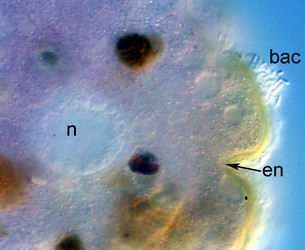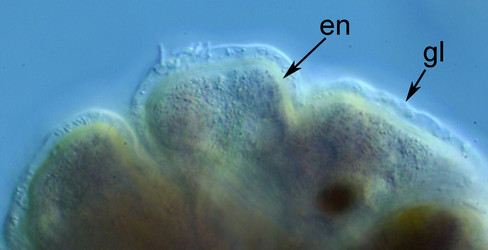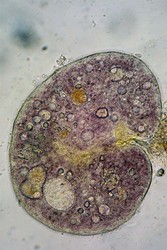Amphizonella
Amphizonella violacea
Ralf Meisterfeld and Edward MitchellCharacteristics
The outer shape of Amphizonella violacea is largely mutable. The envelope is flexible, organic, transparent, 1 to 5 mm thick, with undulations and a wrinkled surface. The envelope is usually attached to the cell, but sometimes small parts are not attached. The colour depends on the stage and can vary from almost colourless to violet to brownish yellow (during cyst formation).
The pseudostome is large, but its shape is not very well defined and changing continuously with the movement of the cytoplasm. Generally it looks like an indentured and ramified slit.


Fig. 1: Ovular nucleus (n) with numerous peripheral nucleoli and cell surface with envelope (en) and attached bacteria (bac). © Ralf Meisterfeld
The envelope is normally covered by a hyaline gelatine-like layer which can be up to 25 mm thick (Fig. 1 & 2). In many specimens this layer contains rod like bacteria. The ovular nucleus is ovoid or spherical, the nuclear membrane is easily visible, the numerous (usually more than thirty) nucleoli are mainly concentrated below the nuclear membrane.


Fig. 2: Envelope and gelatinous layer of Amphizonella violacea. © Ralf Meisterfeld
Numerous (usually more than thirty) contractile vacuoles are evenly distributed and discharge into the thin space between envelope and cell surface. In most stages the cytoplasm contains countless small (<1 µm) violet granules which give the whole cell a light to dark violet tint. Prior to cyst formation the cytoplasm becomes dark brown.
The pseudopods are either cylindroid, fan or sword-like. Their plasma is finely granular with rounded ends. Movements sluggish. Dimensions: 95 – 250 µm.
Ecology
The preferred habitat of Amphizonella violacea are xerophilic mosses with extremely fluctuating water contents which can typically be found on roofs and with lower frequencies on walls, concrete surfaces or rocks. In addition to the rapidly changing humidity, these biotopes are characterised by large temperature changes (daily and seasonally).
Feeding
Active amoebae contain several food vacuoles. The content is often already digested, but diatoms, testate amoebae e.g. Arcella arenaria, Difflugia lucida, as well as members of the moss microflora like cyanobacteria or green algae can be distinguished. The aperture of Amphizonella violacea is very large and flexible enabling the amoebae to ingest large food items like the lobose testate amoeba Microcorycia flava (diameter 125 µm).
References
Meisterfeld, R. & Badewitz, H.J. 2006. A Redescription of Amphizonella violacea (Amoebozoa: Arcellinida). Acta Protozoologica 45: 167-173.
Title Illustrations

| Scientific Name | Amphizonella violacea |
|---|---|
| Location | Aachen, Germany |
| Specimen Condition | Live Specimen |
| Identified By | Ralf Meisterfeld |
| Copyright |
©
Ralf Meisterfeld

|
About This Page
This page is being developed as part of the Tree of Life Web Project Protist Diversity Workshop, co-sponsored by the Canadian Institute for Advanced Research (CIFAR) program in Integrated Microbial Biodiversity and the Tula Foundation.
Ralf Meisterfeld

Rheinisch-Westfälische Technische Hochschule Aachen, Germany
Edward Mitchell

University of Neuchâtel
Correspondence regarding this page should be directed to Ralf Meisterfeld at
meisterfeld@rwth-aachen.de
and Edward Mitchell at
edward.mitchell@unine.ch
Page copyright © 2008 Ralf Meisterfeld and Edward Mitchell
All Rights Reserved.
- First online 02 September 2008
- Content changed 02 September 2008
Citing this page:
Meisterfeld, Ralf and Edward Mitchell. 2008. Amphizonella . Amphizonella violacea . Version 02 September 2008 (under construction). http://tolweb.org/Amphizonella_violacea/124475/2008.09.02 in The Tree of Life Web Project, http://tolweb.org/








 Go to quick links
Go to quick search
Go to navigation for this section of the ToL site
Go to detailed links for the ToL site
Go to quick links
Go to quick search
Go to navigation for this section of the ToL site
Go to detailed links for the ToL site